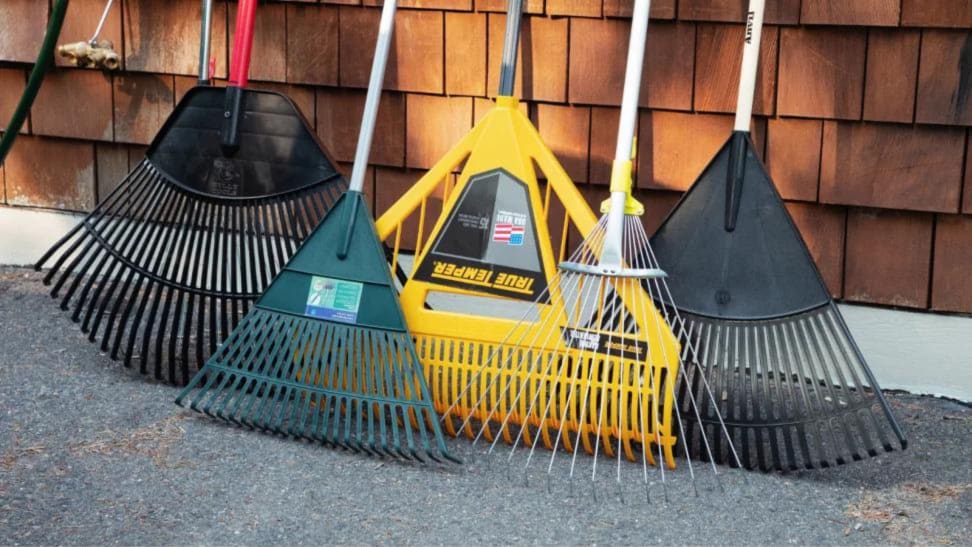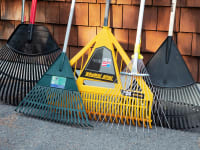 Credit:
Reviewed / Jackson Ruckar
Credit:
Reviewed / Jackson Ruckar
Products are chosen independently by our editors. Purchases made through our links may earn us a commission.
What could be simpler than raking leaves? A lot of things, it turns out—especially if you’re dealing with a big yard and mature trees. The almost-endless supply of leaves can be overwhelming.
If you're a new homeowner and wondering how to rake leaves, we have the answers. With some basic tools and techniques, you can rake up fall leaves in no time and have a pristine fall lawn.
1. Use the right rake
There’s more than one type of rake out there. When learning how to rake leaves, you want the Goldilocks of rakes–one that’s just the right length for you, and isn’t too heavy or too light.
In our testing, we found the Goldilocks of rakes to be the Truper Tru Tough rake with its sturdy wood handle and metal tines. This rake gets most of the leaves in one go, making raking leaves more efficient.
Not sure what size you need? A rake handle should reach the bridge of your nose, and allow you to space out your hands when you hold it. You can buy a telescoping rake with an expanding head such as the Tabor Tools telescopic rake that can change handle length and head width.
2. Get a better way to lift leaves
Repeat after me: A rake is not a shovel. This is a crucial lesson when it comes to how to rake leaves. Rakes aren’t designed to withstand the stress of hoisting leaves, particularly wet leaves, with their tines. If you repeatedly lift leaves with your rake to get them into a garbage can or a compost pile, you will break your rake. Unless you enjoy trips to the hardware store, get in the habit of lifting your leaves some other way.
Here are a few options if you can’t use the Force to levitate leaves with your mind like Yoda.
Use a tarp
Put a large tarp or an old sheet on the ground and rake your leaves onto it. Fold the tarp’s corners to the middle, grasp the corners, and carry or drag the leaf-filled tarp wherever you want your leaves to go. You can also use a rolled-up tarp as a funnel to guide leaves into bags.
Use a snow shovel
Snow shovels are designed for lifting and scooping heavy, wet snow, and are far sturdier than rakes. (Plus, you’ll have an early reminder to find it before the first snow falls in a month or two.)
Use claws
There are a variety of plastic leaf scoops, leaf claws, and hand rakes for sale that extend your hands into paws for grabbing and carrying leaves—or you could use two garbage can lids.
3. Wear gloves
When figuring out how to rake leaves, you don't need to invest in many tools, but you certainly need gloves. Save yourself some blisters and wear gardening gloves. Don’t worry, we did the dirty work for you to find the best gardening gloves out there right now.
We like the Showa Atlas gloves because they’re great in both wet and dry conditions, perfect for handling piles of damp or dry leaves.
While you’re at it, put on long sleeves, long pants, and closed-toed shoes to keep hidden twigs from scratching you—and consider wearing a dust mask. Shoveling leaves can stir up a lot of materials you may not want to breathe, especially if you have asthma or allergies.
4. Rake with the wind, not against it
Why not let nature work for you for a change? Rake your leaves in the direction they’re moving anyway. You don’t have to leave them on the far side of the yard. Rake them onto a tarp, them move the leaf-filled tarp to the final destination. The same logic applies to raking leaves downhill when you can.
5. Avoid raking after the rain
One thing that that's certain when it comes to how to rake leaves is that raking wet, heavy leaves is a great way to break your rake. Wait until the leaves dry out a little, and some of them might blow into your neighbor’s yard in the meantime.
6. Avoid raking leaves into one giant pile
It’s fun to jump in giant piles of leaves — but it’s almost impossible to move them, and making giant piles involves a lot of tedious walking back and forth. Save your back and your legs by raking sections of your yard, then moving the reasonable-sized piles to your compost heap or lawn bags.
7. Instead of raking, turn leaves into compost
Sure you could use a leaf blower to blast all your leaves into oblivion, or at least your neighbor’s yard—but leaves are free compost, with plenty of nutrients to nourish your lawn. The trick is to get the leaves to break down quickly enough so they won’t smother your grass.
Consider letting the leaves stay where they fall and using a mulching mower to cut your leaves into manageable pieces to enrich your soil. The best lawn mower we’ve ever tested happens to also be a mulching mower.
Leaf mulch even seems to smother lawn dandelions. Just remember, mulching mowing works better if you mow regularly through the fall, so you aren’t trying to grind up too many leaves at once.
The product experts at Reviewed have all your shopping needs covered. Follow Reviewed on Facebook, Twitter, Instagram, TikTok, or Flipboard for the latest deals, product reviews, and more.
Prices were accurate at the time this article was published but may change over time.


